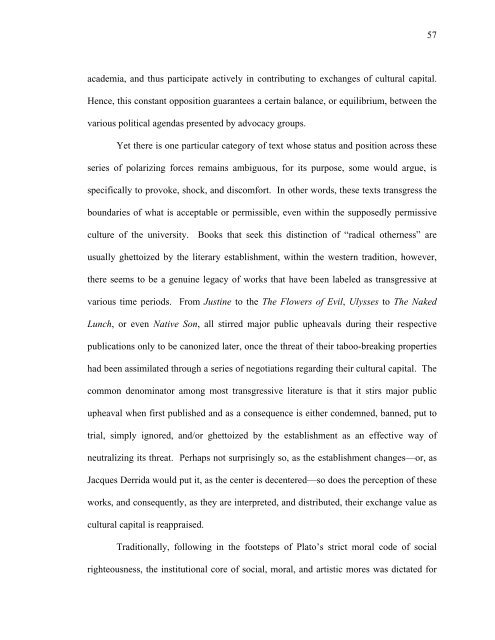Untitled - Sexey's School Moodle
Untitled - Sexey's School Moodle
Untitled - Sexey's School Moodle
Create successful ePaper yourself
Turn your PDF publications into a flip-book with our unique Google optimized e-Paper software.
academia, and thus participate actively in contributing to exchanges of cultural capital.<br />
Hence, this constant opposition guarantees a certain balance, or equilibrium, between the<br />
various political agendas presented by advocacy groups.<br />
Yet there is one particular category of text whose status and position across these<br />
series of polarizing forces remains ambiguous, for its purpose, some would argue, is<br />
specifically to provoke, shock, and discomfort. In other words, these texts transgress the<br />
boundaries of what is acceptable or permissible, even within the supposedly permissive<br />
culture of the university. Books that seek this distinction of “radical otherness” are<br />
usually ghettoized by the literary establishment, within the western tradition, however,<br />
there seems to be a genuine legacy of works that have been labeled as transgressive at<br />
various time periods. From Justine to the The Flowers of Evil, Ulysses to The Naked<br />
Lunch, or even Native Son, all stirred major public upheavals during their respective<br />
publications only to be canonized later, once the threat of their taboo-breaking properties<br />
had been assimilated through a series of negotiations regarding their cultural capital. The<br />
common denominator among most transgressive literature is that it stirs major public<br />
upheaval when first published and as a consequence is either condemned, banned, put to<br />
trial, simply ignored, and/or ghettoized by the establishment as an effective way of<br />
neutralizing its threat. Perhaps not surprisingly so, as the establishment changes—or, as<br />
Jacques Derrida would put it, as the center is decentered—so does the perception of these<br />
works, and consequently, as they are interpreted, and distributed, their exchange value as<br />
cultural capital is reappraised.<br />
Traditionally, following in the footsteps of Plato’s strict moral code of social<br />
righteousness, the institutional core of social, moral, and artistic mores was dictated for<br />
57



